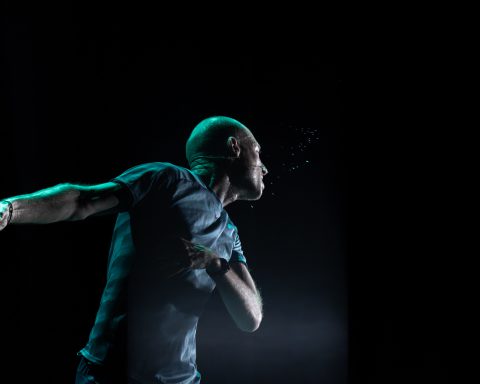By Ana Beatriz Ribeiro
If you live in Leipzig, you might pass this building everyday, without imagining what it was once like, or what it once represented. Now it’s abandoned, a canvas for graffiti, an incongruous, one may even say ugly, city center sight with its odd shape. But such incongruity was once motive for pride, and done on purpose.
I went to Leipzig’s latest documentary film fest, DOK 2015, with the intent of watching local productions, because I wanted to learn more about the history of the place I live. And so I did, and was fascinated with the movies on my Sunday marathon, but particularly with one of them. I’d become interested in the history of this particular building, the old Bowlingtreff at Wilhelm-Leuschner-Platz, when someone told me some months ago that he was trying to get city approval, partners and resources together to renovate it. At 60 minutes long, the documentary of the same name sounded to me like the perfect opportunity to get a glimpse into the role the bowling alley had played in the life of the city, before the venue fell into a deep slumber in 1997.
But I didn’t expect the documentary “Bowlingtreff” to be so well-shot and profound, or the now-decrepit building to have been so important; and judging by the long, loud, super-enthusiastic wave of applause from the Schaubühne Lindenfels audience, I assume others felt the same way. The 2015 movie, directed and produced by Thomas Beyer and Adrian Dorschner, takes us deep into the building’s bowels and projects, sometimes literally, on its decaying halls and bowling lanes the bygone world of youth, excitement and hope that once populated it. But it was also a world that would herald the arrival of neoliberal Kapitalismus and which would fall apart, ironically, just seven years after the end of the GDR where it thrived. It wasn’t clear to me from the movie exactly why the building was abandoned, left to turn into a water-infiltrated cavern (though its lanes and some of its colors remain), when so many people seemed to be so fond of it.
The Bowlingtreff was much more than a bowling alley: It was a way to escape the Plattenbau reality of the GDR. It was unapproved abundance and ostentation. It was a form of defiance by Leipzig, indeed signaling the times soon to come.
In the movie we hear from the architects and others who dreamed it up, and how and why they dreamed it up, and how they managed to build it in 1987. They did it underground, with loads of volunteers, and without approval from the central administration in Berlin. They used the interior of a former transformer station and a facade design inspired by the old Panorama that long ago stood in the area, with a post-modern twist. They filled the inside of the building with yellow and pink, palatial columns and stairways, statues, expensive marble, Moorish-style internal windows, a gym with state-of-the-art machines one couldn’t find anywhere around. You have to see it yourself to believe it.
The good news is that you have two opportunities that I know of to watch “Bowlingtreff” for free this month (i.e. via live streaming online):
- Sunday, November 8th (tomorrow): MDR Fernsehen at 11:55 p.m.
- Wednesday, November 25th: NDR Fernsehen at midnight.








